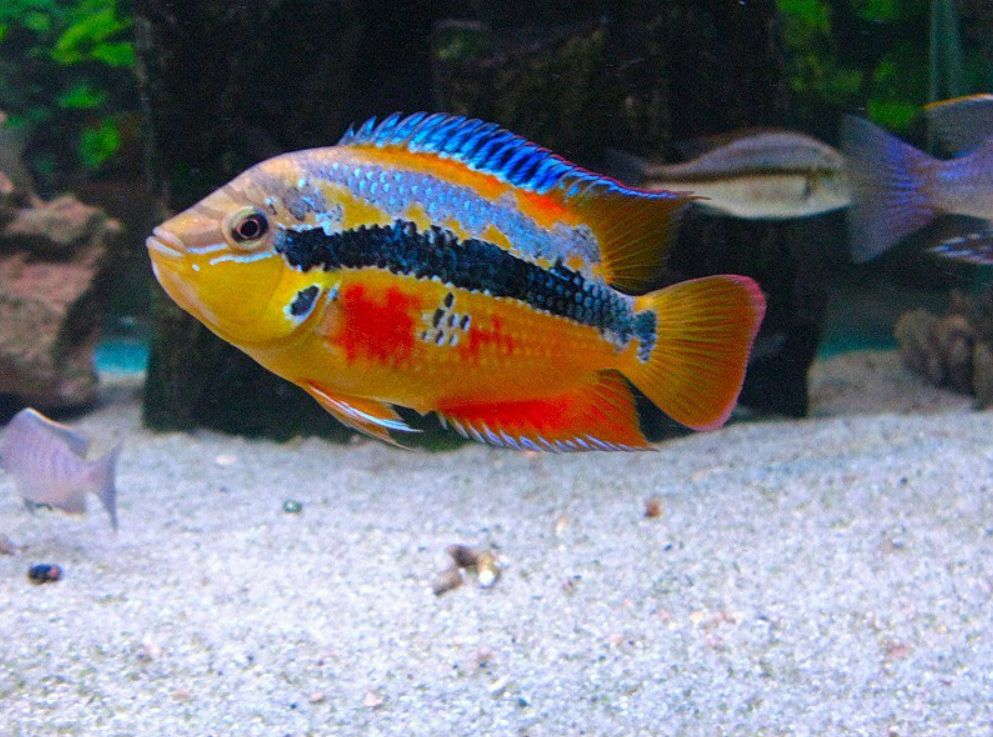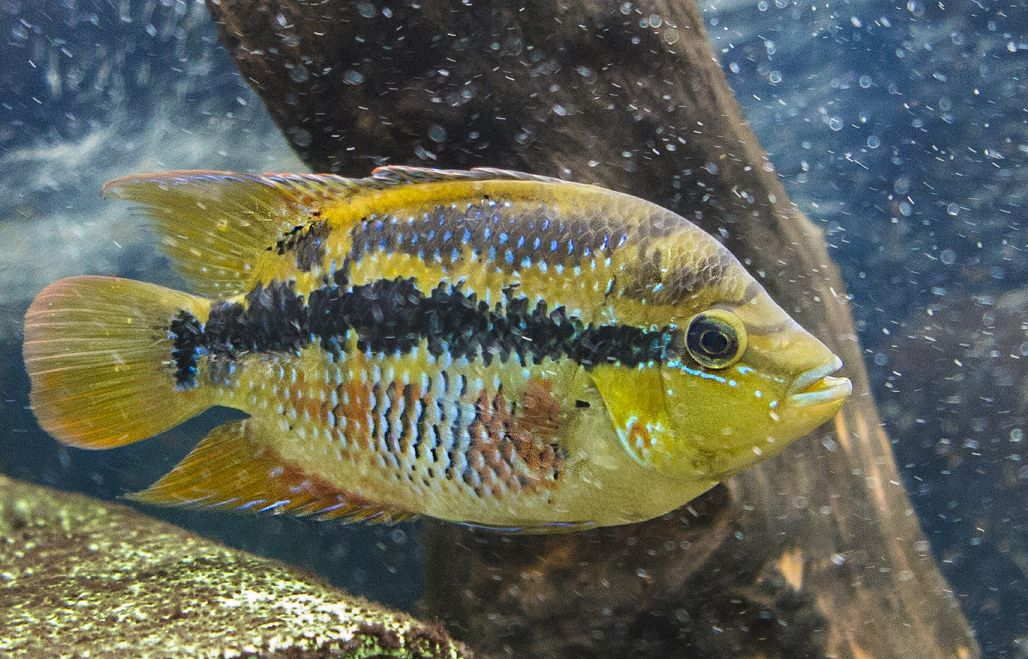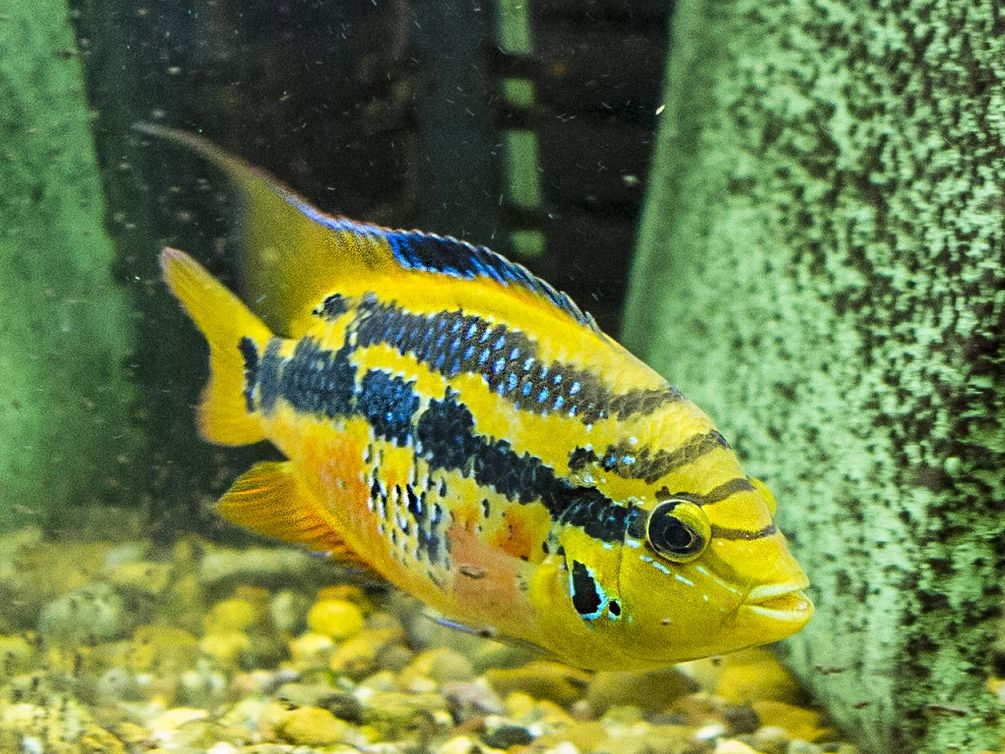The salvini cichlid is a vibrant freshwater fish belonging to the cichlid family, known for its striking colors and attractive appearance. As with many cichlid species, the salvini cichlid can exhibit aggressive behavior, as it is highly territorial. This fish is also a predator, meaning it may view smaller fish as potential food. For this reason, it is advisable to keep salvini cichlids in separate tanks or with larger, more compatible species. When considering tank mates, options such as larger tetras or barbs can work well, provided the environment is spacious enough to reduce territorial disputes. Understanding these characteristics is crucial for successful tank management and ensuring the well-being of all fish involved.

Contents
Habitat in the wild
The salvini cichlid, also known as the tricolor cichlid or yellow belly cichlid, is a freshwater fish from the diverse cichlid family, scientifically classified as Trichromis salvini. This family includes hundreds of species found in various regions worldwide, celebrated for their vibrant colors, unique behaviors, and diverse shapes and sizes.
Native to the rivers of Mexico, Belize, Guatemala, and Honduras, the salvini cichlid thrives in waters that flow into the Atlantic Ocean. It has also been introduced to certain areas in southern Florida, where it has established populations. The fish is most commonly found in rivers, lakes, and freshwater lagoons along the Atlantic seaboard. It prefers small rivers with moderate to fast water flow, typically at elevations not exceeding 500 meters above sea level.
As an omnivorous species, the salvini cichlid has a varied diet that includes juveniles, insects that fall into the water, small crustaceans, larvae, algae, and aquatic plants. This diverse diet helps sustain its energetic nature and contributes to its adaptability in different environments.
The salvini cichlid was first described in 1862 by German zoologist Albert Gunter, but it wasn’t until the late 20th century that aquarists successfully began keeping this species in home aquariums. Understanding the natural habitat, diet, and historical context of the salvini cichlid can enhance the experience for those interested in adding this striking fish to their collection.

Description
Size
Males of the salvini cichlid typically grow up to 18 cm (7.09 in) long, while females reach a maximum size of 15 cm (5.9 in). However, individual sizes can vary based on genetics, diet, and environmental factors. In aquariums, their growth can be influenced by tank size and the quality of care provided. Offering a spacious tank and a balanced diet is essential for promoting healthy growth in these vibrant cichlids.
Body
The salvini cichlid features an elongated, laterally compressed body, with a striking marigold yellow base color. Along the center, a row of large anthracite-colored spots adds to its appeal, accompanied by a smaller lateral stripe of similar spots just above. The fish has a prominent head, fleshy lips, and large eyes with striking red irises. Its gill covers are adorned with small turquoise green spots and lines. Young salvini cichlids may not appear particularly attractive, but they transform into eye-catching adults, making a stunning addition to any aquarium.
Lifespan
The lifespan of salvini cichlids typically ranges from 7 to 10 years. However, individual lifespans can vary significantly based on factors such as care quality, diet, water conditions, and genetics. Understanding these aspects can help ensure that your salvini cichlid thrives and reaches its full potential in your aquarium.
| Characteristic | Description |
|---|---|
| Scientific Name | Trichromis salvini |
| Common Names | Salvini cichlid, Tricolor cichlid, Yellow belly cichlid |
| Family | Cichlidae |
| Origin | Central America (Mexico, Belize, Guatemala, Honduras) |
| Habitat | Freshwater rivers, lakes, and ponds |
| Size | Up to 6-8 inches (15-20 cm) in length |
| Lifespan | 5-10 years (varies based on care and environment) |
| Coloration | Vibrant colors; males typically have more intense hues |
| Behavior | Territorial and can be aggressive, especially during breeding |
| Diet | Omnivorous; accepts various types of food |
| Tank Requirements | Minimum tank size of 50 gallons (190 liters) or larger, plenty of hiding spots, rocks, and plants |
| Water Parameters | Temperature: 75-82°F (24-28°C), pH: 6.5-7.5, hardness: 8-15 dGH |
| Breeding | Substrate spawner; lays eggs on flat surfaces |
| Compatibility | Can be aggressive towards other fish, especially during breeding; careful selection of tankmates required |
| Special Considerations | Monitor water quality, provide a balanced diet, and create appropriate territories to manage aggression |
Difficulties in keeping
Salvini cichlid can be recommended for experienced aquarists, since it’d be quite challenging for the beginners to keep it. However, the fish is rather undemanding and it can live in small tanks, but at that it my demonstrate aggression towards its tank mates. This fish requires frequent water renews and proper care.
Care and keeping in a tank
Tank Size
The salvini cichlid thrives in a spacious environment, with a minimum recommended tank size of around 50 gallons (190 liters) for a single fish. For those looking to maintain multiple salvini cichlids in a community setup, a larger tank—such as 75 or 100 gallons—is ideal. In larger tanks, aim for at least 30-40 liters per fish to ensure they have adequate space to establish their territories.
Cichlids are territorial, especially during their spawning period, which can lead to increased aggression. Providing a roomy tank helps reduce conflicts by allowing them to claim individual territories. Additionally, incorporating plenty of hiding spots, rocks, and plants creates a more natural and secure environment, further minimizing aggression among tank mates. Always consider the number of fish, their behavior, and other tank occupants when determining the appropriate tank size.
Tank Decor
The salvini cichlid is not overly demanding regarding substrate, although small pebbles or granite chipplings are preferable. To support live plants, ensure the substrate layer is about 8 cm thick and features a robust root system. Caves, driftwood, and rocks can serve both as decorative elements and hiding spots for the fish. These shelters provide security while also enhancing the visual appeal of the aquarium.
It’s important to create a balance in the tank design, allowing free swimming space in the center while positioning decorations and plants near the walls and corners. Salvini cichlids do not damage plants or dig, making a well-planted tank visually attractive and beneficial for their well-being.
Water Parameters
The ideal water parameters for salvini cichlids include a temperature range of 24–26 °C (75.2–78.8 °F), hardness of 5–20°, and a pH of 7.0–8.0. Moderate lighting is best, as these fish enjoy hiding among floating plants and in caves.
Clean water is crucial; maintain low levels of nitrites and ammonia through regular water changes of up to 30% daily, along with an external filter. Salvini cichlids appreciate some water flow, which can easily be created with a good filter. Additionally, equip the tank with a heater featuring a thermostatic switch to ensure stable temperatures.
Diet
In the wild, salvini cichlids are omnivorous, primarily feeding on aquatic organisms and small insects. In captivity, they thrive on a varied diet that includes high-quality cichlid pellets, live or frozen foods, and flakes.
For a balanced diet, consider the following options:
- High-Quality Cichlid Pellets: These commercially available pellets should be formulated for omnivorous fish, containing both animal and plant-based ingredients to meet their nutritional needs.
- Live or Frozen Foods: Offer brine shrimp, bloodworms, daphnia, and small insects to provide essential proteins that enhance coloration and encourage natural feeding behaviors.
- High-Quality Flakes: Flake foods specifically designed for cichlids can be included as a dietary supplement, ensuring variety and completeness in their nutrition.
By adhering to these guidelines for tank size, decor, water conditions, and diet, you can create a thriving environment for your salvini cichlids, ensuring their health and happiness in your aquarium.
Tank mates
Are salvini cichlids aggressive? Sure. You should keep in mind that the fish is an aggressive one. They are especially aggressive towards its kind. Therefore, it’s quite difficult to organize keeping of more than one male fish in a tank.
The fish is definitely not for community tanks with small fishes like neon tetra or guppies in them. Is a predator and it’ll treat any small fishes only as food. Also they are territory dependent and will chase away any other fishes from its territory.
Catfishes such as common pleco or sailfin pleco will be the best tank mates for this fish. Though, it can live together with other cichlids — convict cichlid, blood parrot, firemouth cichlid, oscar, jack dempsey, green terror.
Keep in mind that, the larger is the cichlid, the more spacious tank it requires. Especially, is they start spawning. Of course, it’s better to keep them separately from other fishes. But if don’t have this chance, they’ll become less aggressive if provided with high feeding and lots of shelters in the tank.

Gender Differences: Male vs. Female
Distinguishing between male and female salvini cichlids can be useful for aquarists, although the differences may not be apparent until the fish reach sexual maturity. Here are some general characteristics to help identify their gender:
Male Salvini Cichlid:
- Size: Males are typically larger and more robust, reaching lengths of up to 18 cm (7.09 in).
- Coloration: Adult males display vibrant colors, often exhibiting bright yellow, orange, or red hues, particularly during breeding.
- Markings: Males have more pronounced and extended black markings on their bodies and fins.
- Dorsal Fin: The dorsal fin is generally elongated and pointed.
- Behavior: Males tend to be more aggressive, especially during the breeding season as they defend their territory.
Female Salvini Cichlid:
- Size: Females are usually smaller and slimmer, not exceeding 15 cm (5.9 in).
- Coloration: Their colors are more subdued and less vibrant compared to males.
- Markings: Females have shorter and less pronounced black markings.
- Dorsal Fin: The dorsal fin is shorter and more rounded.
- Behavior: While females can also be territorial, they are generally less aggressive than males.
These characteristics serve as guidelines, and identifying gender may still be challenging, especially in immature individuals. Observing behavior during breeding can provide more definitive clues, but it’s essential to handle them carefully to minimize stress.
Breeding
Salvini cichlids reach reproductive maturity between 10 and 12 months, forming monogamous pairs as early as six months old. Despite their relatively small size, they are extremely protective of their territory, which can span up to 2 meters in diameter. While they can spawn in a community tank, it is advisable to set up a dedicated breeding tank to reduce stress on both the parents and potential offspring.
A breeding tank of at least 100 liters is recommended, equipped with numerous shelters. The pair typically lays and fertilizes eggs on vertical surfaces such as driftwood or rocks. They prepare the spawning site by cleaning the substrate, with the genital papilla becoming visible 24 hours prior to spawning.
To facilitate spawning, maintain proper conditions, including a temperature increase of 2–4 °C and regular water changes of up to two tank volumes weekly. If the pair opts for an open space to spawn, it’s crucial to provide overhead cover with driftwood or floating plants to prevent delays.
The female lays up to 500 eggs on a smooth surface. After spawning, the male takes on the role of protector, while the female fans the eggs with her pectoral fins. Any damaged or white eggs are typically consumed by the parents. The eggs hatch within three days, releasing relatively large larvae that initially rely on their yolk sacs for nourishment.
Once the yolk is depleted, juveniles begin to swim and search for food, which can include leftover bits among the plants or brine shrimp nauplii. It’s crucial to maintain a stable water temperature, ideally not exceeding 26 °C, to avoid high mortality rates among the young.
Both parents are involved in caring for their offspring for an extended period. Under stress-free conditions, juveniles can remain with their parents. However, if aggression is observed, it’s wise to separate the young fish into a different tank to ensure their safety.